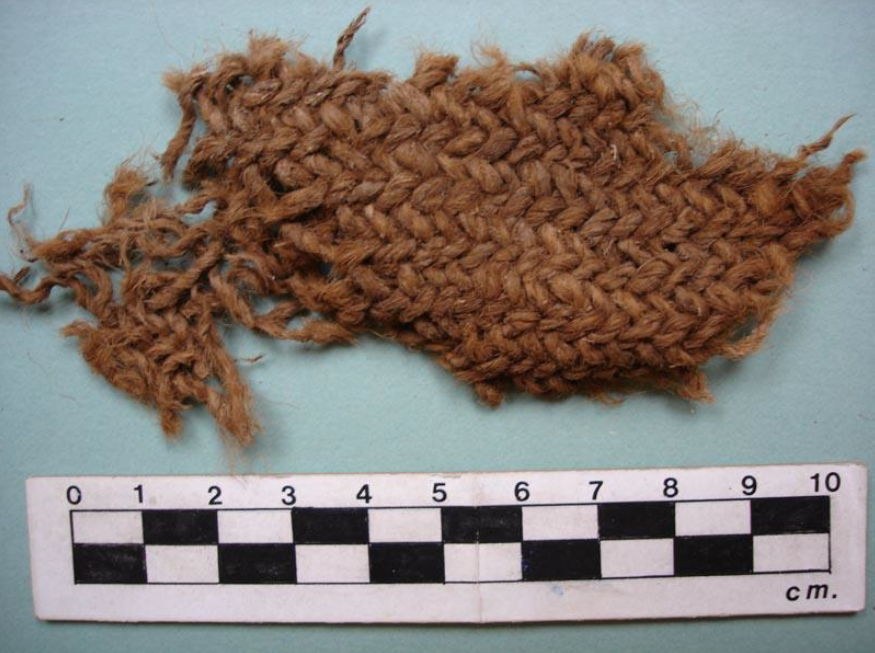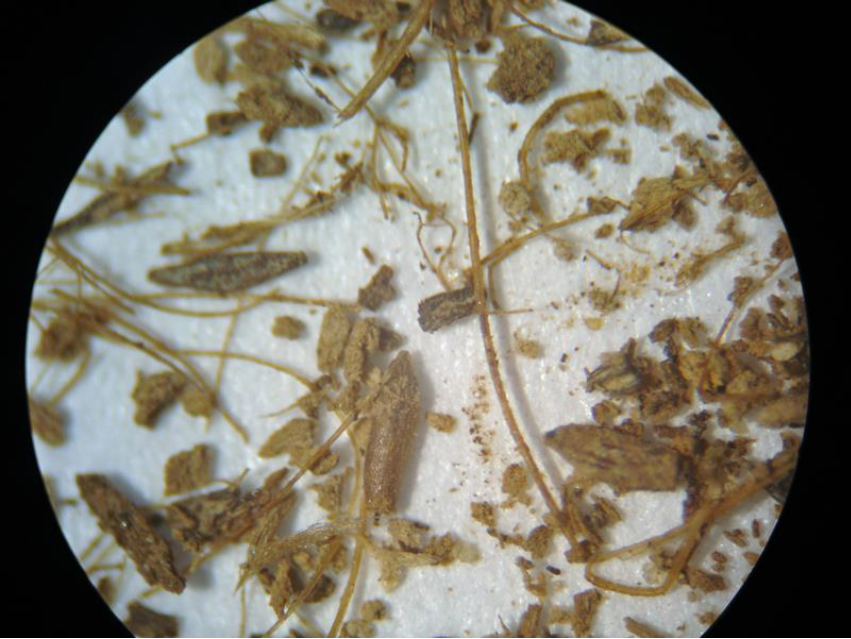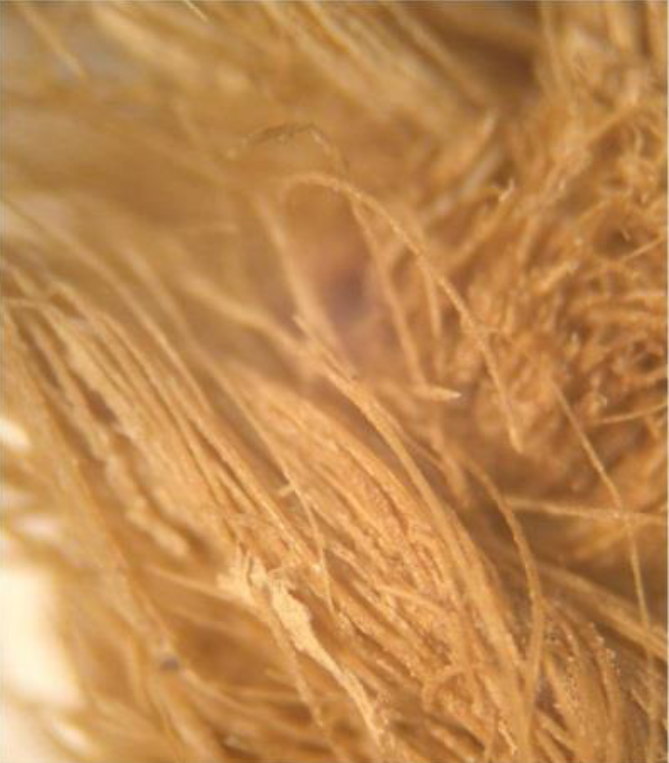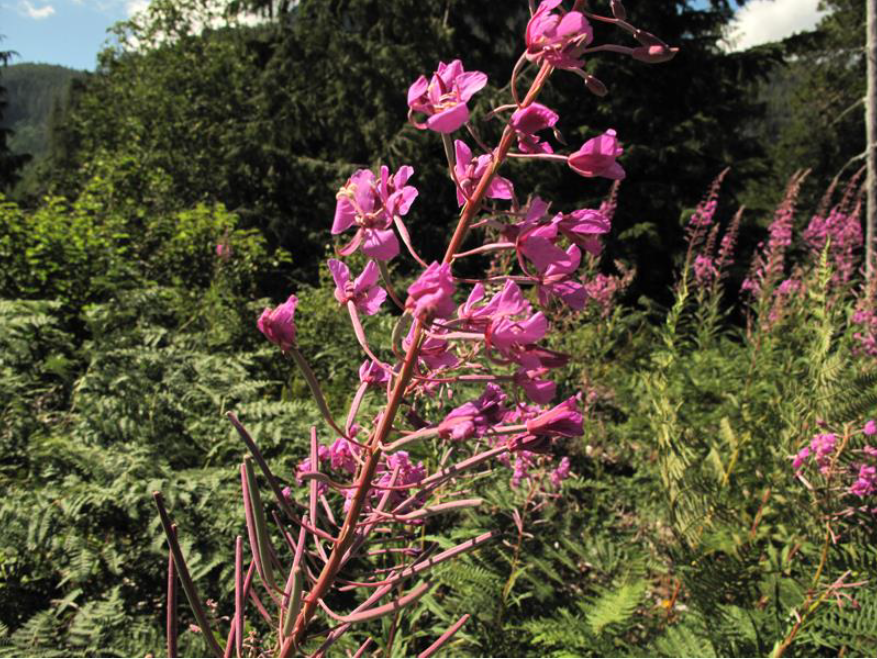Small fragments of woven material were found along with other items in a burial cave site on Gabriola Island in 1971. The Burial remains and associated artifacts were brought to the (then) Provincial Museum to protect the material that was being removed by unknown persons.

Cloth made from the woven seed plume of the Fireweed plant (DhRx-28:13; accession 71-233). (Grant Keddie photo).
Artifacts found in the cave included bracelets of copper and brass, shell pendants, a stone bead, a green glass wire wound Chinese made bead, a woven rattle head and bark matting, in addition to the small fragments of unidentified woven material. This assemblage of material suggested that the woven material likely dated to around the late 18th to early 19th century.
In 2001, the Snuneymuxw First Nations and the Royal B.C. Museum held discussions for the repatriation of their ancestral remains from a number of archaeological sites, as well as 460 boxes of soil samples and faunal material – mostly from the Departure Bay and Duke Point sites. A ceremony was held at the Royal BC Museum and at the final re-burial ceremony at Nanaimo on October 20, 2001.
During the repatriation process, C-tasi:a – Geraldine Manson, of the Snuneymuxw First Nation, brought a group of elders to the Royal BC Museum, to examine the artifacts to be reburied. The elders held discussions among themselves and agreed that they would allow for small fragments of woven material to be kept for future examination to determine what they were made of.

Microscopic view of seed and plume fibres found in the piece of woven cloth
(100X). (Grant Keddie photo).
I examined this cloth fragment under a 200X power microscope with the intent of trying to find hair samples that could be identified as either from dog or mountain goat. The latter are well known to have been used in making several types of blankets. But there were no examples of hair to be found.
What I did find was a mass of tiny plant-like fibres and many tiny seeds. Using our Museums comparative plant and seed collection, I was able to identify the seeds as those of the common fireweed plant, Epilobium angustifolium.

Epilobium angustifolium seeds and plume from RBCM herbarium collection (400X). (Grant Keddie photo).
I surmised that the fibres must be from the plume (the fluff) of the fireweed plant. This proved to be the case even though they were of different thicknesses. It turns out that the fibre thickness varies with the amount of water that the plant has during it active growing stage.

Microscopic View of masses of seed plume fibres in the piece of woven cloth (200X). (Grant Keddie photo).
What is significant about this find is that this cloth fragment is the first and only example of clothing made entirely out of the plume of the fireweed and not just a mixture with other raw material in the clothing construction.
The Early Ethnographic Accounts
In the ethnographic literature it is important to see if statements about plant use are coming from First Nation advisors who have personal experience with the use of fireweed and not just statements by writers repeating the information that previous ethnographers had received.
Myron Eells collected information in the 1870s and 1880s from First Nation advisors who would be knowledgeable about traditional practices, based on their personal observations, from the early 1800s. In speaking about Puget Sound in general and specifically including the Squaxin, Klallam, Skokomish and Twana, Eells notes that: “Fireweed (Epilobium). The cotton-like down from the seed was formerly used in making blankets” (Eells 1985:52). Eells indicates that there are three kinds of blankets: “One was made of dog’s hair, geese or duck down, and the cotton from the fireweed. These were twisted into strings and woven together” (Eells 1985:122).
Edward Curtis, recorded from his First Nation advisors (some of whom were born as early as the 1832 to 1850 period) that the Klallam on the Olympic Peninsula and North Strait Salish speakers on the south end of Vancouver Island “used on special occasions a robe woven from a mixture of down with the hair of goats and dogs and with certain vegetal products. The down of ducks, geese, and gulls, the hair of dogs and mountain goats, and sometimes the cottony fibre of dead fireweed blooms and cattail spikes, were taken in varying proportions and thoroughly mixed by beating and stirring vigorously with a paddle. The resultant fibre was then twisted into loose, fluffy strands, ready for the weaving” (Curtis 1913:44).
Curtis’s statements are confirmed by Erna Gunther’s Quileute and Cowlitz First Nation advisors, in 1924-25, who had never seen a woman weaving a mountain goat blanket, but: “Much more common were blankets made of the fireweed cotton mixed with feathers of seagulls or ducks”. These were pounded together and spun using a spindle whorl (Gunther 1927:221).
Conclusion
It is fascinating to see the ingenuity of the Snuneymuxw First Nations in producing a quality cloth with the very fine seed plume of the fireweed by itself. It is likely that this practice was more wide-spread than previously believed.
References
Curtis, Edward S. 1913. Salish Tribes of the Coast. The North American Indian. Vol. 9, pp.175, Norwood, Mass.
Eells, Myron. 1985. The Indians of Puget Sound. The Notebook of Myron Eells. Edited with an introduction by George Pierre Castile. Afterword by William W. Elmendorf. University of Washington Press, Seattle and London, Whitman College, Walla Walla, Washington.
Gunther, Erna. 1927. Klallam Ethnography. University of Washington Publications in Anthropology. 1(5):171-314, University of Washington Press, Seattle, Washington.



